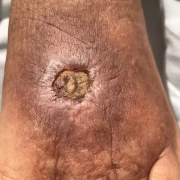What Does MRSA Look Like
Sometimes things are not what they seem. A visitor commented that he thought his wife had been bitten by a brown recluse which looked just like a bite, but instead, it turned out to be an MRSA Staph Infection.
Here is information on this infection that can mimic a spider bite. Want to see what happens when a bite gets infected? Then check out our section on Staph Infection.
So, what is Methicillin Resistant Staphylococcus Aureus?
Staphylococcus aureus (staph) is a bacteria (germ) found on and in healthy people’s skin and nose. It also grows in wounds or other body parts, sometimes causing an infection. For example, staph is one of the most common causes of skin infections.
They used to prescribe Penicillin for the treatment of staph infections. However, over time many staph bacteria have become difficult to treat with Penicillin and antibiotics related to Penicillin.
These new or resistant forms of Staphylococcus aureus are called methicillin resistant staphylococcus aureus, or MRSA. The illnesses they cause are the same as those caused by other staph; the difference is how they are treated.
MRSA
MRSA looks like a normal staph bacteria in the early stages and usually doesn’t cause disease until it enters an opening in the skin. Some people are at higher risk of carrying MRSA or becoming infected with this type of staph.
MRSA more often occurs in people in hospitals and healthcare facilities. It can also happen outside the hospital in people who receive multiple antibiotics, as well as in people who have close contact with a person carrying the germ or by touching objects contaminated with MRSA (e.g., clothes, towels, bedding, athletic equipment, benches in saunas or hot tubs, bandages).
Staph bacteria (including MRSA) are most often spread by close contact with infected people or the things they touch. It is not spread through the air.
Many people don’t realize they carry staph bacteria on their skin. A MRSA or other staph infection’s symptoms depends on the infection’s location. The most common are skin infections, and can cause symptoms such as redness, warmth, pus, and a wound that does not heal.
Your doctor may refer to these infections as boils, furuncles, impetigo, or abscesses. Infections can also develop in the blood, bone, bladder, lungs, and other sites. Symptoms there will depend on the site of infection but include fever and pain at the site.
Think you have MRSA?
Do you have MRSA or other staph infections? If so, you should see your healthcare provider. It can be hard to tell what MRSA looks like, and tests are the best way to find out if you need treatment, but don’t wait!
MRSA and other staph infections are treatable! Some staph skin infections can be treated simply by draining the sore and keeping the wound clean. For more severe infections, antibiotics can be used to treat these infections.
If your healthcare provider prescribes antibiotics, it is crucial to finish taking all the pills and call your doctor if the infection does not improve.

I, also have had MRSA…. I had back surgery in May of 2011….came home from the hospital….three weeks later a health care worker who was at my home asked to look at my back….she discovered I had a sore where the surgery site was…it also was draining. I saw some drainage on my panties and gowns several days before; but I thought it was just healing from the back surgery site. I had to go to the hospital and they drew tons of fluid from the wound. The day after that the nerurosurgeon had to take me back into surgery to take care of the problem….because I had MRSA. I spent five days in the hospital, and went home with a PICC line. Also, I had to have a wound vac to drain from my surgery site. Nurses had to come to my home each day, and every week they had to draw blood to send to the infectious control doctor. This went on for weeks; but finally I was off of the PICC line and other meds. I do not know if MRSA affected my recovery; but here it is almost ayear later and I have some much pain in my legs I can not stand up or sit down or walk without terrible pain. I had to leave my job at a hospital after 24years, and get disability.